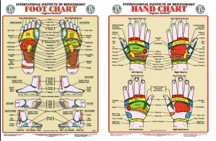Reflexology
Who uses Reflexology?
Reflexology applies to anyone seeking improved health. Relaxation alone helps to reduce stress levels and boost the body’s immune system.
Reflexology has gained increasing popularity across Europe and Asia as a stand-alone practice, as a complement to other treatments, and as a preventive therapy. A reflexologist living near industrial zones in Tennessee was able to save companies the expense of carpal tunnel surgery by successfully treating the afflicted employees with Reflexology instead.
“In Denmark, various municipalities and companies have employed reflexologists since the early ’90s. According to several studies, this practice in Denmark has resulted in reduced sick leave and absenteeism, and hence significant economic savings for the employers. Employees have consistently reported complete or partial improvement in conditions where they sought help through Reflexology and even relief for additional problems related to stress. In one municipal district, almost one-third of the employees reported greater satisfaction with their jobs after completing six sessions with a reflexologist.”
Where are the reflexes located?
In Reflexology theory, reflex points and areas on the feet and hands correspond to specific organs, glands, joints and body systems. The entire body and all its parts are represented on the feet, each foot or hand reflecting half of the body. Practitioners access these points and apply pressure to affect organs and systems throughout the entire body.
Many maps of reflex points have been developed over the years, the original modern map having been developed in the first half of the 20th century by Eunice Ingham, who is known as the “pioneer of modern Reflexology.” Each foot or hand represents half of the body vertically:
- The left foot corresponds to the left side of the body, and all organs, glands, body parts, etc. found on the left side are found on the left foot or hand. For example, the spleen is found on the left side of the body and so the reflex for the spleen is found on the left foot.
- The right foot corresponds to the right side of the body, and all body parts found on the right side of the body are found on the right foot or hand. For example, the ascending colon is on the right side of the body, and therefore the corresponding reflex area is on the right foot.
- The toes represent the head, the pad of the foot represents the chest area, the arch of the foot represents the abdomen, and the heel represents the pelvis. The inside (or medial) sides of the feet correspond to the center of the body and the spinal reflexes. The outside of the feet (or the lateral side) correspond to the outside of the body and the shoulder, knees and hips.
The illustration below shows Reflexology maps for the feet and the hands.
What is involved in a typical Reflexology session?
A reflexologist most often conducts a full, general session. However, he or she may emphasize specific problem areas on the feet or hands. For example, if time is limited and the person really needs to relax, the reflexologist may choose to work mainly the diaphragm and the head reflexes, and use relaxation movements. If someone has sciatic pain, the reflexes of the lower back and the hip are emphasized.


